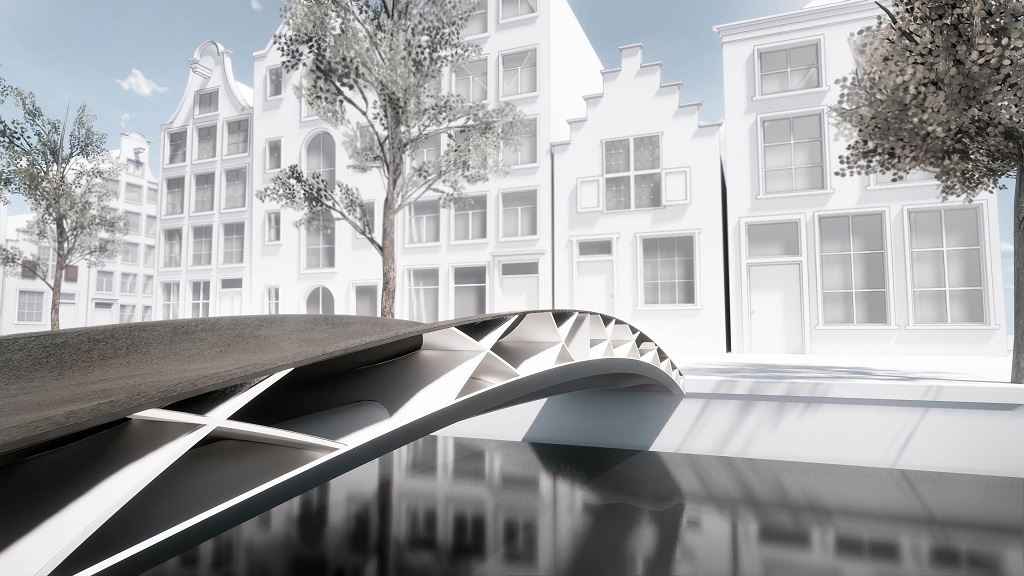![The lightweight 3D printed FRP pedestrian bridge prototype [Image: DSM]](https://fabbaloo.com/wp-content/uploads/2020/05/FRPbridge_img_5eb0913018999.jpg)
It’s not the first 3D printed pedestrian bridge, nor the first 3D printed polymer bridge. But a new lightweight 3D printed bridge is still noteworthy.
Remember, it doesn’t have to be the first of its kind to be notable. Time will tell, of course, if this particular bridge is the best of its kind, or the gateway to more of its kind.
3D Printed FRP Bridge
![A segment of the 3D printed bridge [Image: Royal HaskoningDHV]](https://fabbaloo.com/wp-content/uploads/2020/05/FRPbridgesegment_img_5eb0913068c92.jpg)
The latest bridge prototype grabbing 3D printing headlines comes from a collaboration from engineering and project management consultancy Royal HaskoningDHV, global materials and general science company DSM, and large-scale 3D printing equipment supplier CEAD.
So what is new about this structure? Maurice Kardas, Business Development Manager at Royal HaskoningDHV, explains:
“This partnership is bringing about a paradigm shift in the way we think about the form and function of bridges in our society. FRP bridges are already well known for having a longer lifetime expectancy with lower life cycle costs compared to steel bridges. What’s new here is the use of a new 3D printing technology, enabling us to print large scale continuous fibre reinforced thermoplastic parts. Using this new composite thermoplastic material, we will be ushering in a new era for sustainability and push the boundaries of bridge functionality even further.
By including sensors in the design, we are able to build a digital twin of the bridge. These sensors can predict and optimise maintenance, ensure safety and extend the life span of our bridges. It can also incorporate new functionalities such as monitoring vital environmental aspects and improve the decision-making process for maintenance and inspection via dynamic real-time reports on the condition of the bridge. In collaboration with these industry leaders, we are transforming the traditional playbook when it comes to bridge design and construction.”
Picking through this (and ignoring the “paradigm shift” aspect), we see that the structure is an FRP pedestrian bridge — that is, a fiber-reinforced polymer bridge.
It’s 3D printed using a composite material that the release notes is a glass-filled thermoplastic PET combined with continuous glass fibers. That PET is Arnite, a high-strength material from DSM — strengthened even further and designed to be 3D printed.
Arnite, DSM notes, is more sustainable than other material options and offers more design versatility. DSM has been highly attuned to the drive in 3D printing toward sustainability, and so is underscoring that the materials used for this bridge are recyclable, as well as used only in required amounts due to the less wasteful additive manufacturing process.
Going on in Kardas’ explanation, we see that the large-scale 3D printing is key — and that’s where CEAD comes in.
The Dutch company has been progressing in its work with continuous fiber additive manufacturing, offering a high-strength, large-scale 3D printing process. According to the team, applications like this bridge are exactly why they have been developing that process:
“This 3D printed bridge prototype demonstrates the huge strides that we are making which will transform the future of this industry, not only speeding up construction, but also making the process more cost and time efficient. We developed this technology for exactly these industry applications, making them more sustainable and easier to manufacture,” said CEAD CEO Maarten Logtenberg.
CEAD and DSM are working closely on optimization of the material and 3D printing via predictive modeling to bring the Royal HaskoningDHV bridge design to fruitful life.
3D Printed Structures
We spend a lot of time examining (and debunking) claims of 3D printing applications in construction.
The application area is certainly interesting and growing — and very, very real. But it’s often still overly built up (pun intended).
This bridge, for example, seems a good stepping stone toward more structures that can be constructed, possibly in place, for pedestrian access.
But it’s still a prototype. Just like work in 3D printing other usable structures, there clearly remains work to be done.
Industry 4.0 Progress
And just like work in such applications, it stands as testament to progress being made in Industry 4.0.
The bridge combines a few major areas of Industry 4.0: 3D printing, composite materials, sustainable development, generative design, predictive modeling, digital twins, collaborative co-creation.
Also notably, the three partners working on this bridge are all Dutch.
While a large benefit of this next Industrial Revolution is that virtual collaboration is increasingly possible, there’s still much to be said for localization of all resources. Some of the most interesting partnerships we’ve seen have sprung into being due to proximity, and surely there are other benefits that can be taken advantage of for such work (think taxes, shipping, face-to-face time, government support, etc.).
Additionally, the Netherlands has been quite a hub of 3D printing bridges, including MX3D’s storied stainless steel structure. Perhaps before too long the canals of Amsterdam will see more of their bridges 3D printed?
This 3D printed FRP pedestrian bridge prototype is very interesting — as a work-in-progress, if not quite as a blanket “world’s first.”
Via DSM

